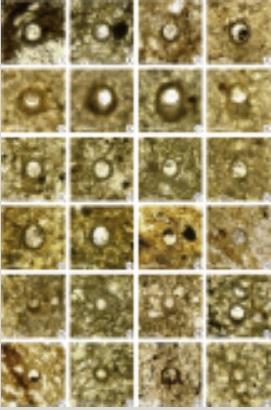Daria K. Ivanova, Diego A. Kietzmann
2 017
Journal of South American Earth Sciences
The Late Jurassic – Early Cretaceous marine sediments of the Andean region show an excellent record of different calcareous microfossils, among which calcareous dinoflagellate cysts stand out. Detailed micropaleontological studies of Vaca Muerta Formation (Early Tithonian – Early Valanginian) in the southern Mendoza Neuquén Basin from three sections are conducted with the aim of establishing a major presence of microfossil representatives from different microfossil groups. The analysis of several thin sections from the outcrops reveals a relatively rich micropaleontological assemblage of calcareous dinoflagellate cysts, as well as levels with poor preserved calpionellids and benthic foraminifera. Particularly, calcareous dinoflagellate cyst includes 24 known species (two of them with two subspecies). Some species with biostratigraphic value of the Tethyan region have been identified also in the Andean region: 1) Committosphaera pulla (Borza) and Parastomiosphaera malmica (Borza) are species known only from Lower Tithonian; 2) Colomisphaera tenuis (Nagy) appears in the latest Early Tithonian; 3) Colomisphaera fortis Řehánek and Stomiosphaerina proxima Řehánek are important markers for the latest Late Tithonian – middle Late Berriasian interval; 4) Stomiosphaera wanneri Borza appears in the middle Late Berriasian; 5) Colomisphaera conferta Řehánek and Colomisphaera vogleri (Borza) appear in the Late Berriasian and marked the Berriasian-Valanginian boundary interval; 6) Carpistomiosphaera valanginiana Borza is a marker for the Lower/Upper Valanginian. More detailed studies of these groups will allow their correlation with Tethyan biozones, and contribute to improve biostratigraphic schemes in the Neuquén Basin.
http://www.sciencedirect.com/science/article/pii/S0895981117301347

